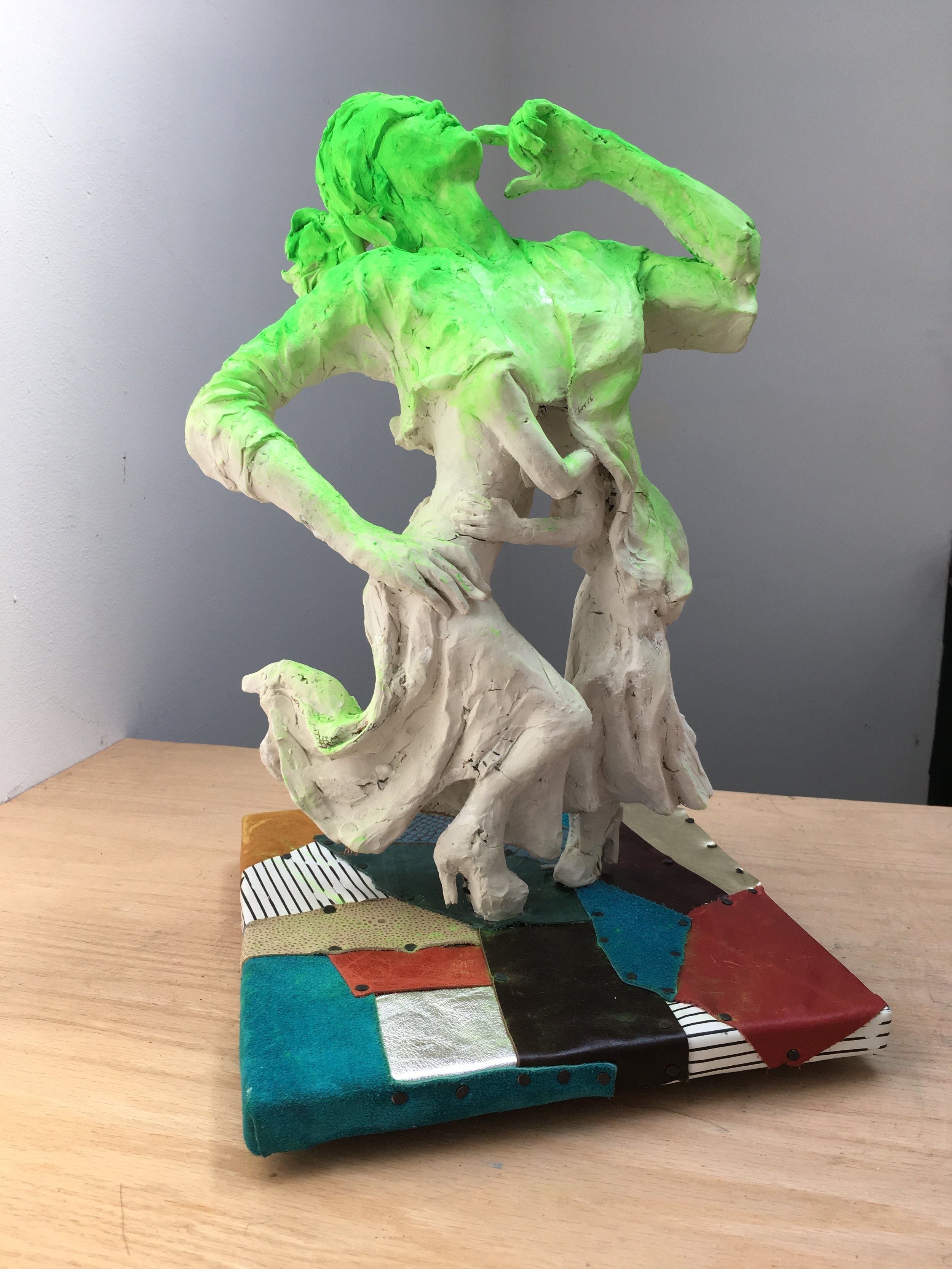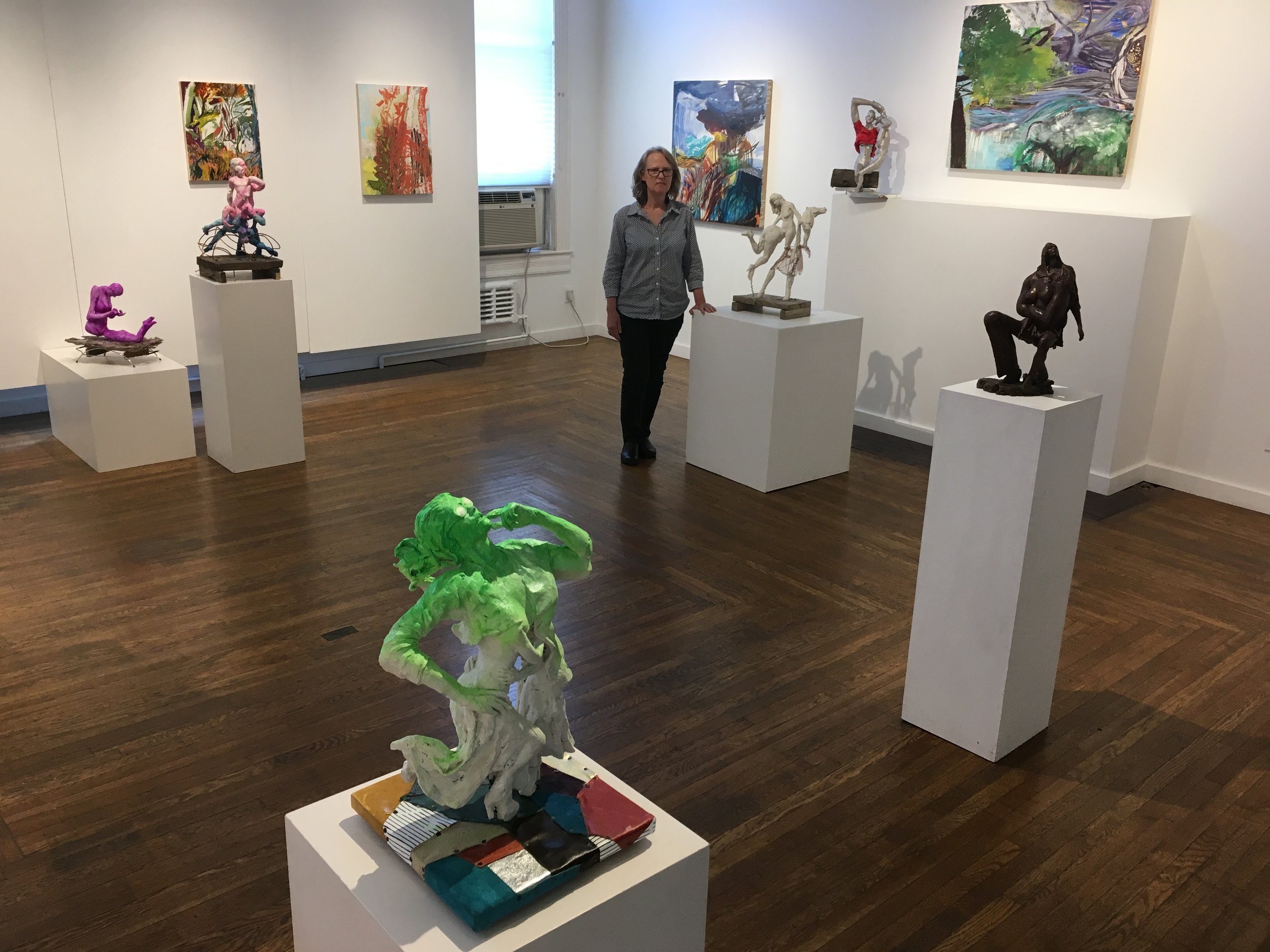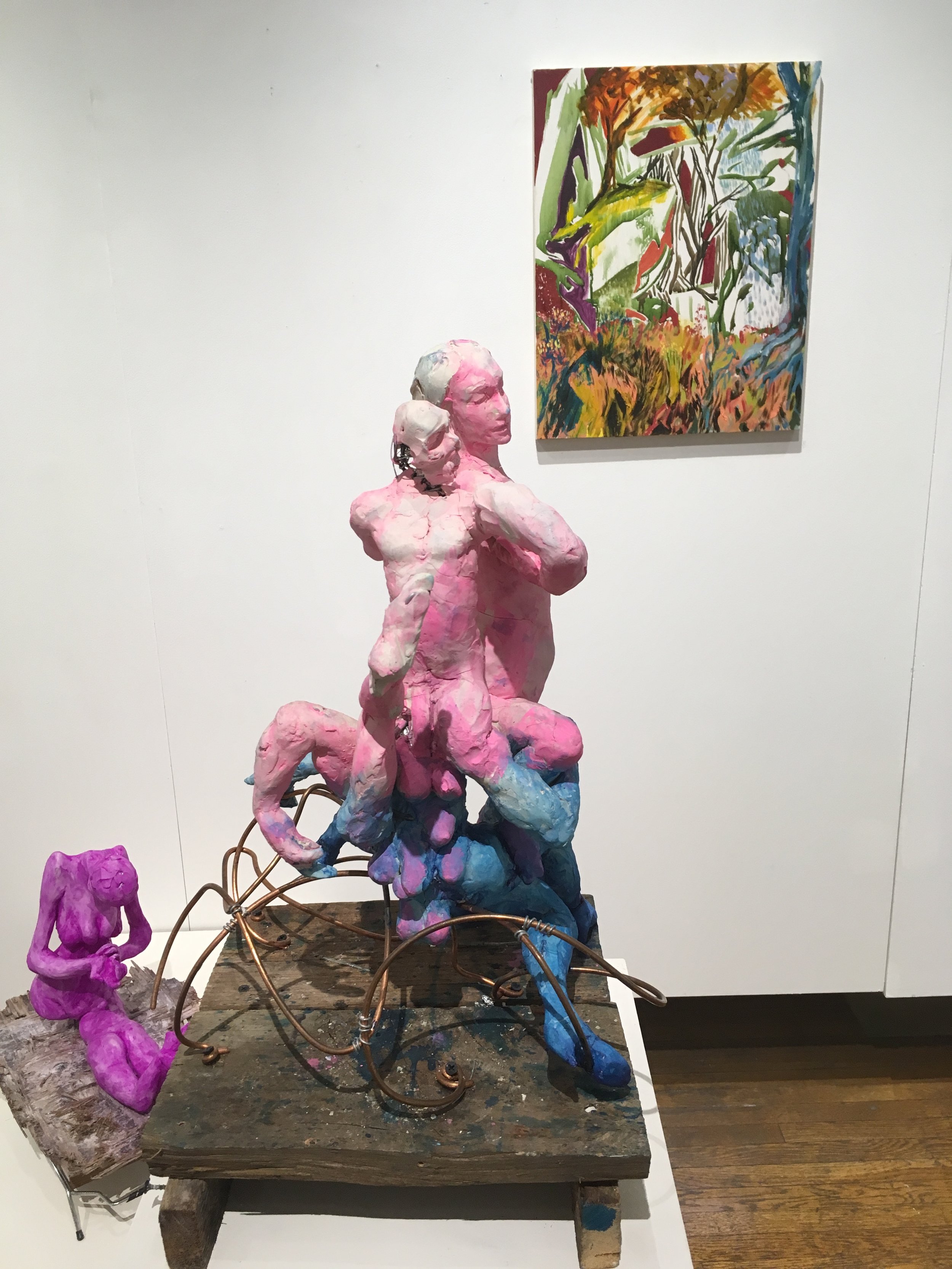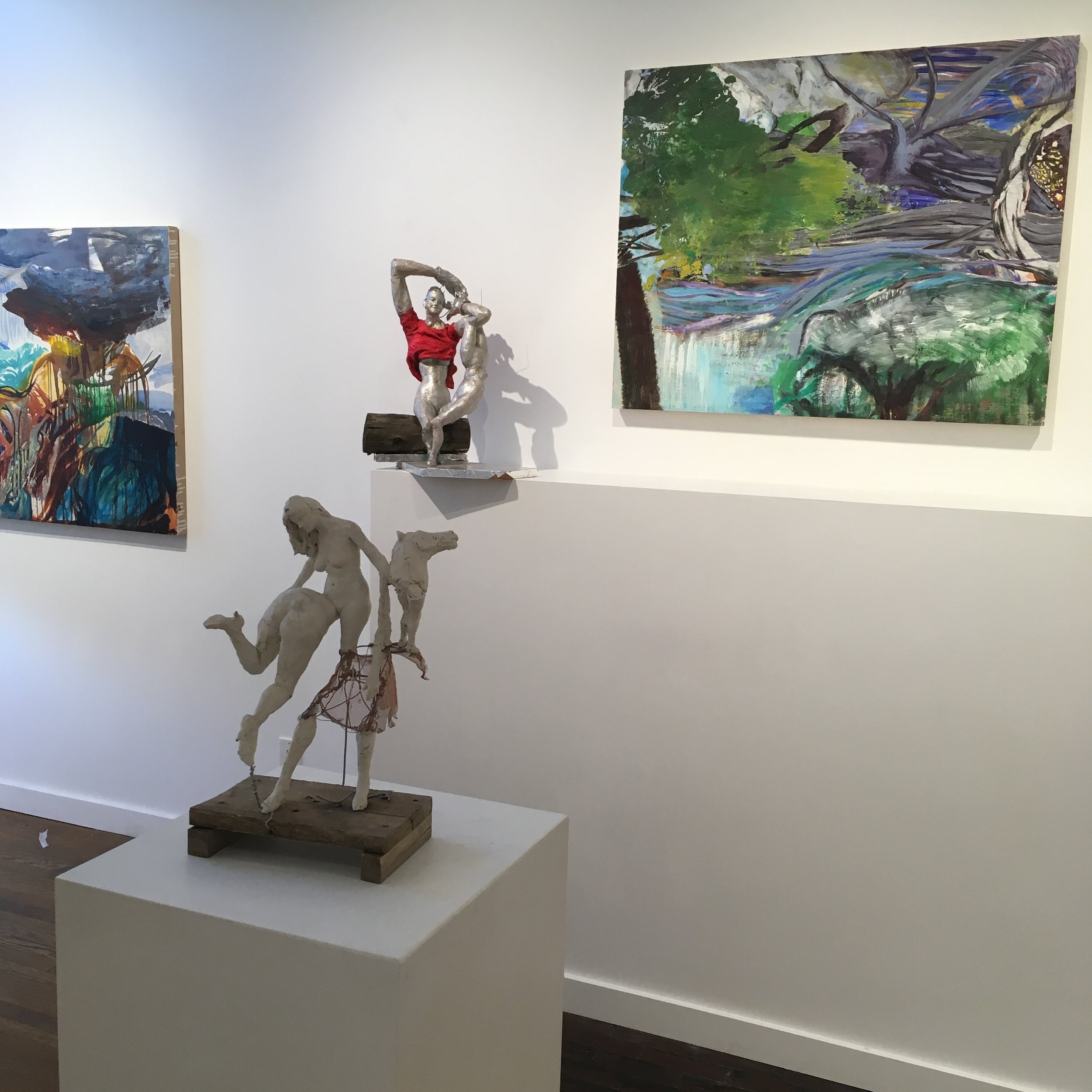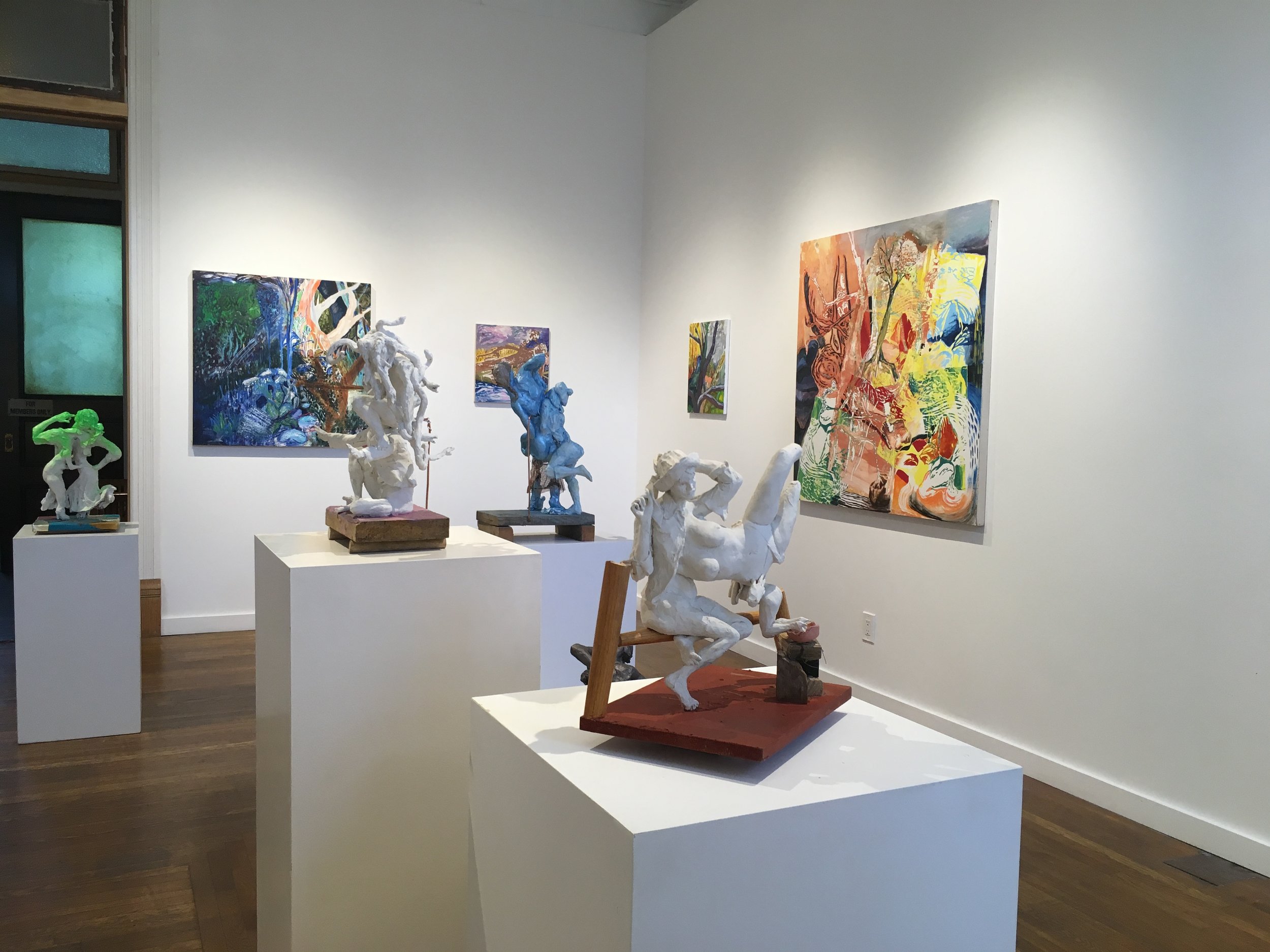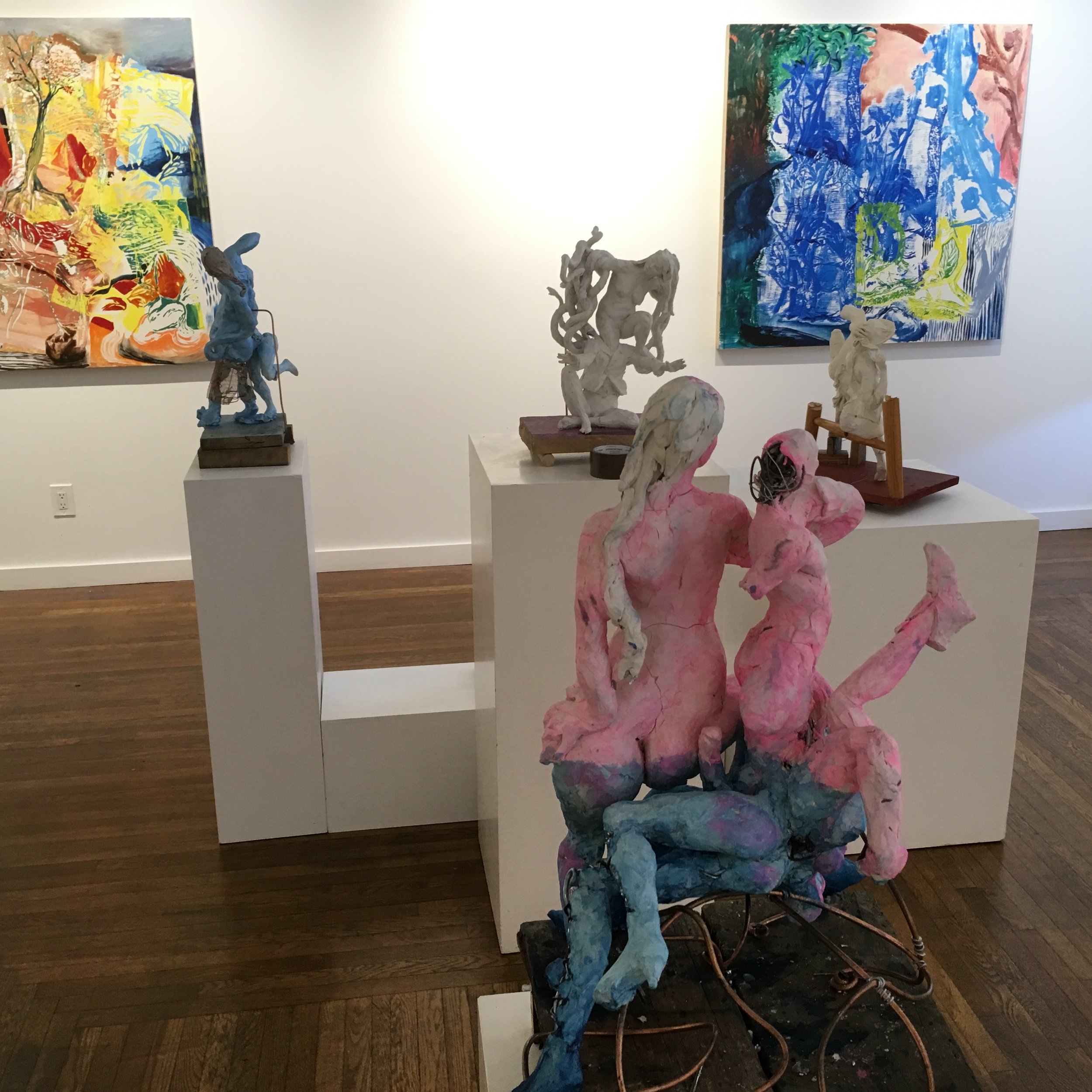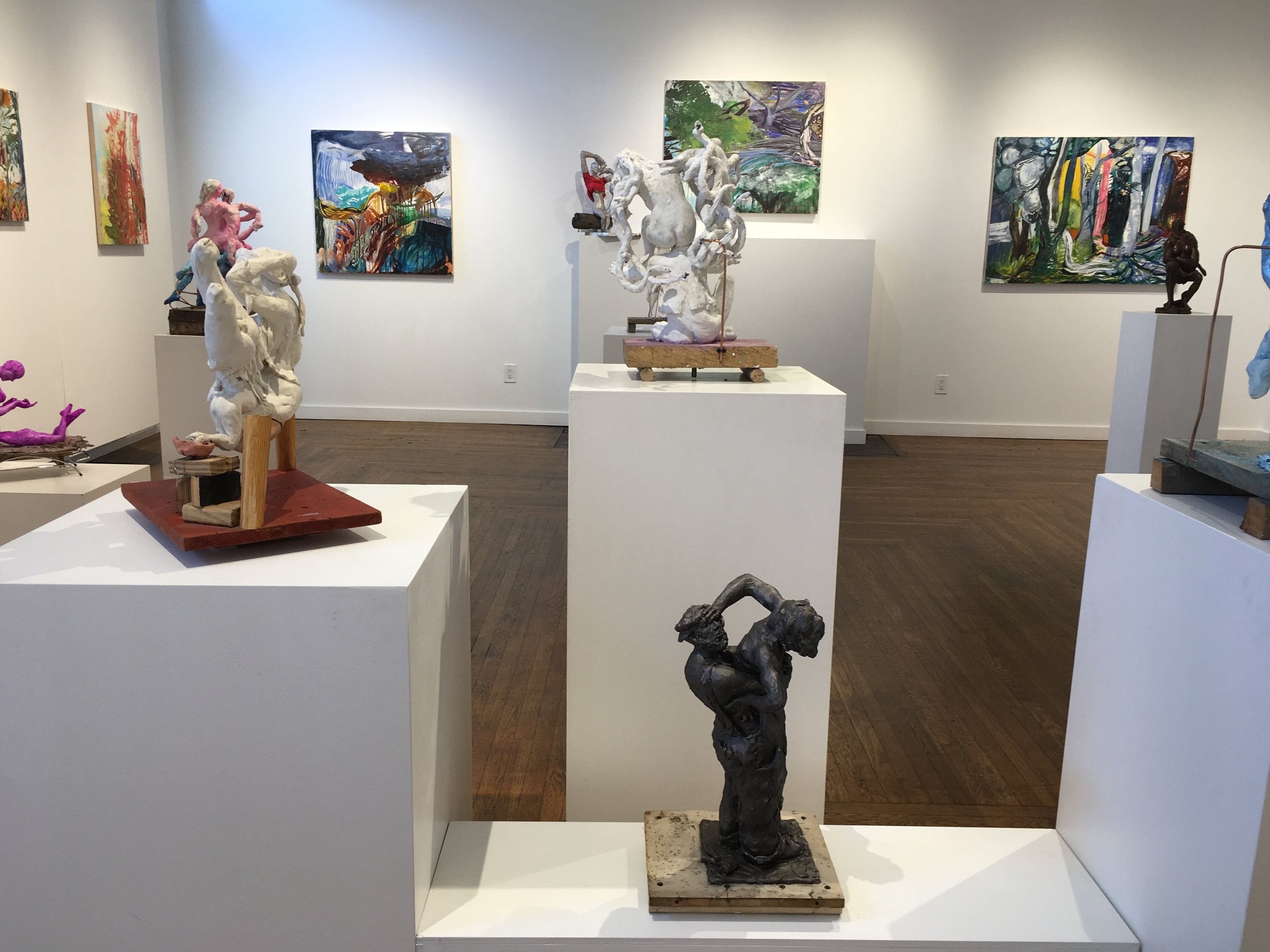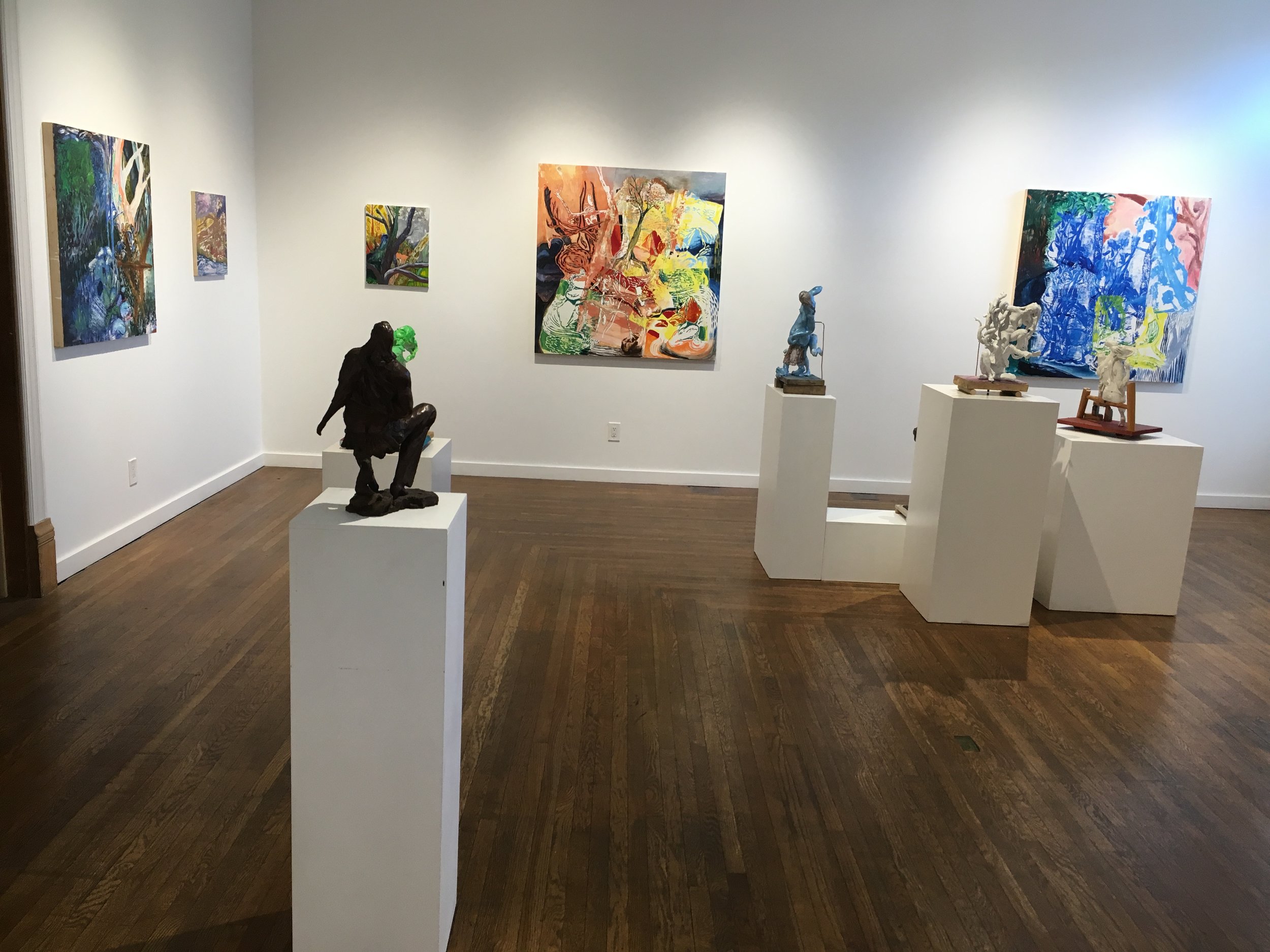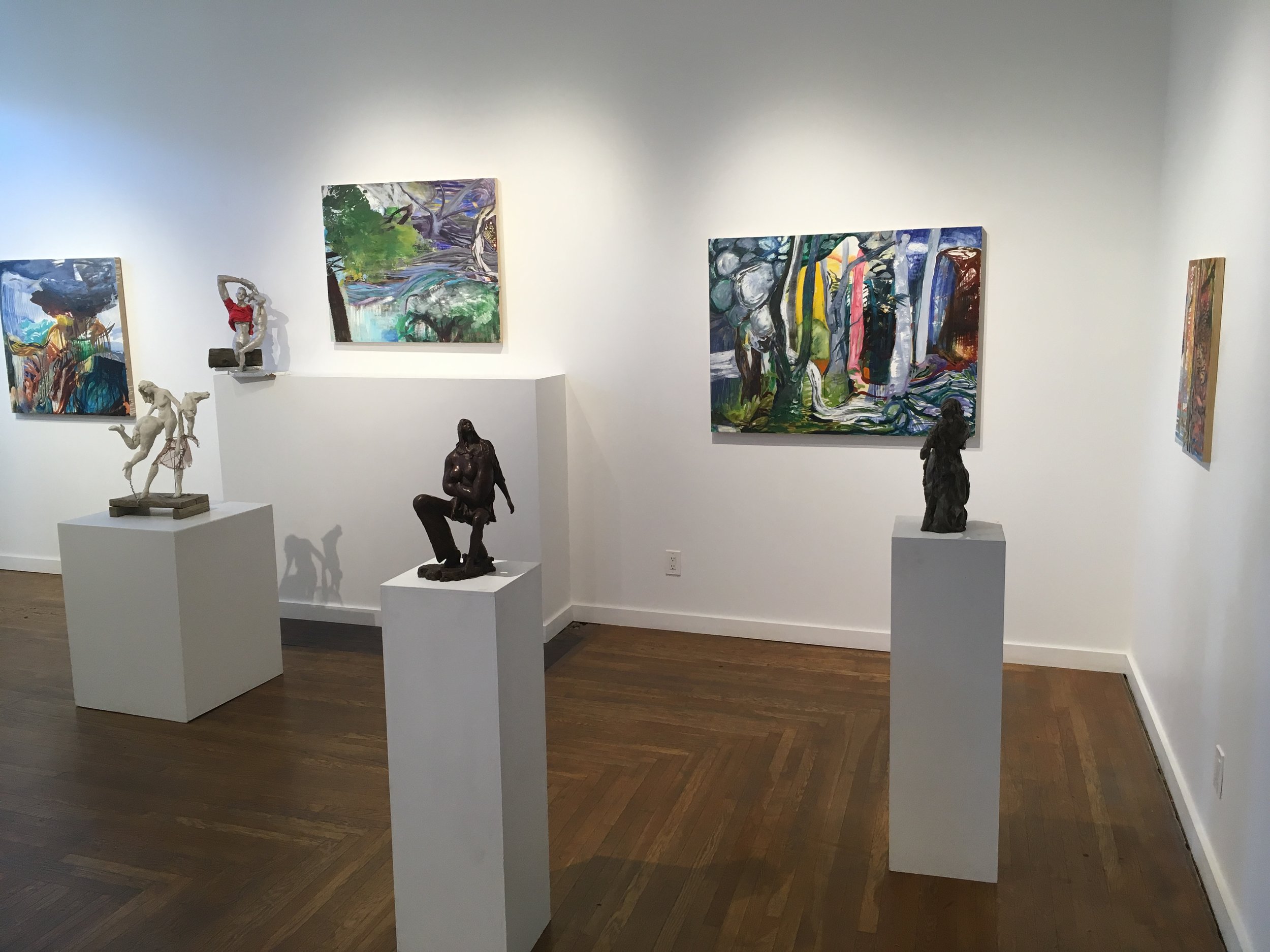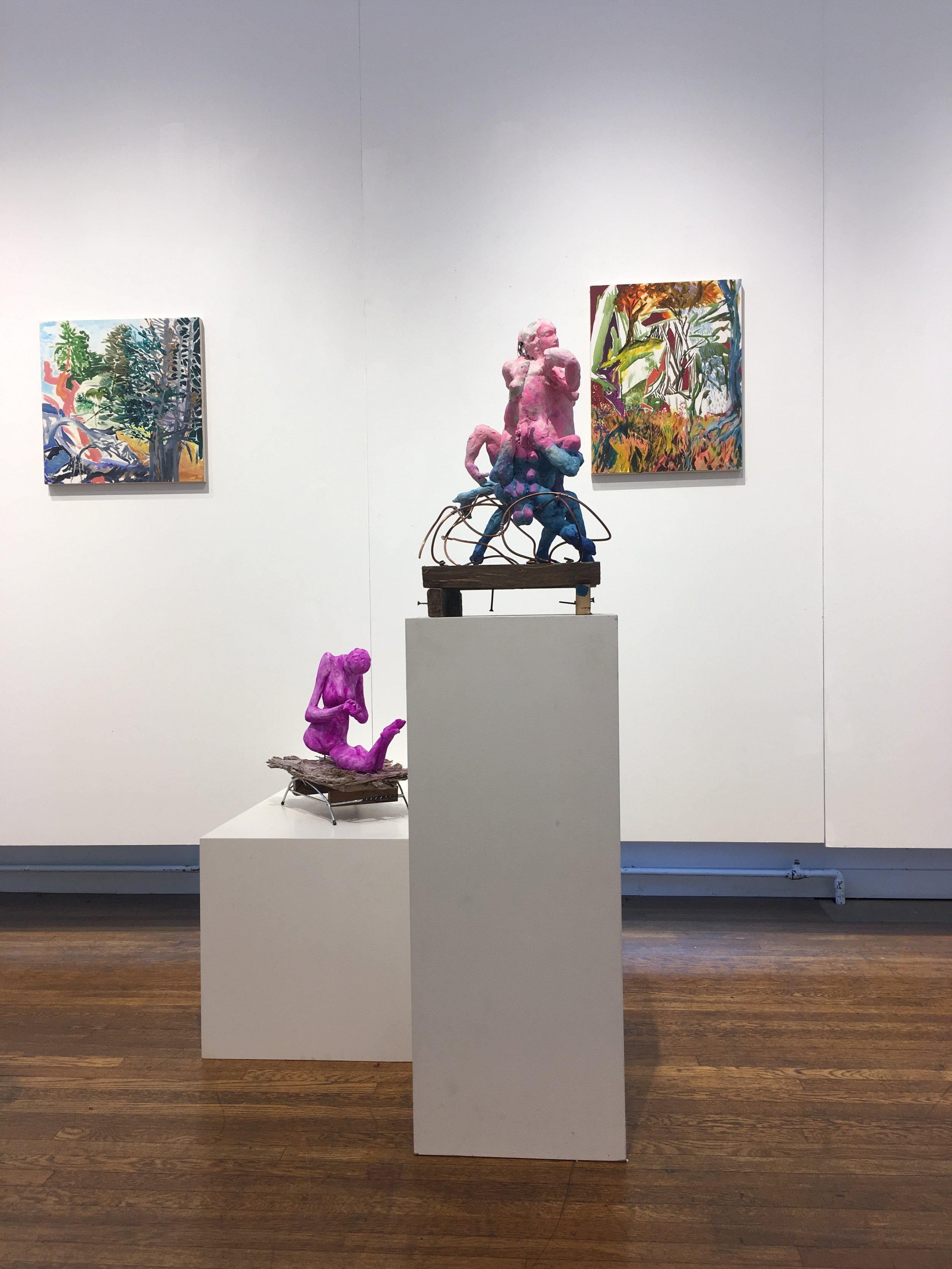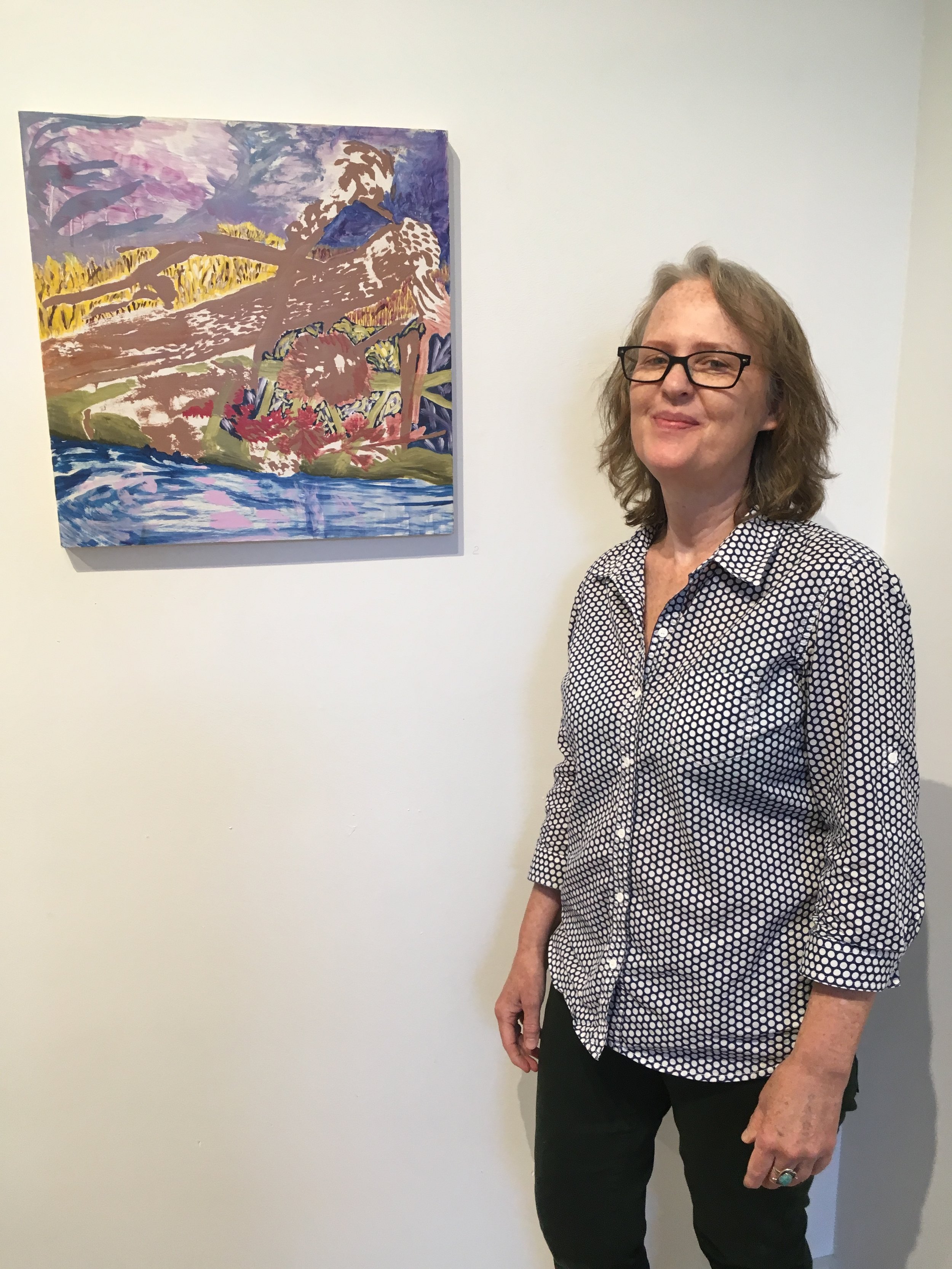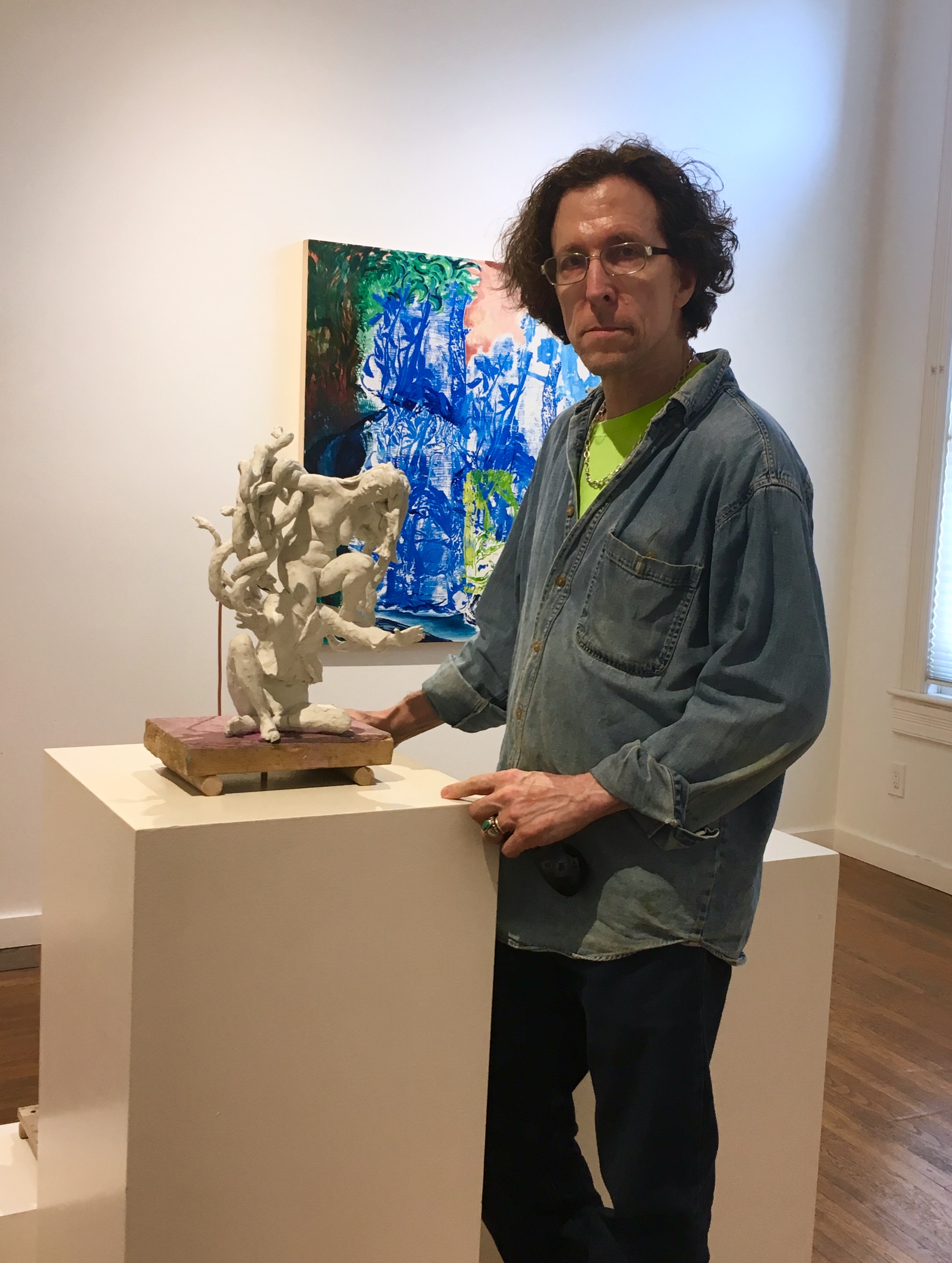2018
“To You, The View To Me”
Hudson Beach Glass Gallery, Beacon NY
"To You, The View, To Me"
Dominique Nahas
catalog essay 2018
Cecilia Whitaker-Doe and Don Doe, as artists, one might argue, could not be more different as it regards their materials (painting, sculpture), their nominal subject matters (nature, the body). Yet were you to strip away surface appearances what reveals itself are strikingly compatible essences, affinities in terms of how intoxicating, how feverish, their individual and singular visions are. Both artists are storytellers, describing states of mind encounters with the self and its fantasies, psychical stories told that infer passaging through hospitable and inhospitable places and visual recounting redolent often-shifting moods centered around a sustained core of transient memory recalling oscillating sensations of groundedness and ungroundedness, surrendering to losing control, journeys emblematic of losing control and attempts at placing markers so as to find one’s way finding one’s way, of negotiating between the seen and the unseen, with emphases on delirium and no small sense of the ecstatic.
> > What strikes me is how reverberatory each of their works are, as a whole. >>>>Pertains to conditions of mind: How deep their curiosity, how extensive they push things, how they stretch to accommodate the not known, how adventurous they are, and also how immensely resourceful and imaginative they are in allowing the emergence of time to resonate through their works. In this respect Don Doe’s work invokes a contemplation of perishability while Cecilia Whitaker-Doe’s paintings resonates with intimations of transience and reciprocity between space, time and the sensing body. Cecilia Whitaker Doe and Don Doe’s various artworks, be they in the form of two or three dimensions, serve as instrumentalities of wonderment at the service of unveiling truth, emotional and psychical truth, and a condition of mind that undergirds and precedes voluntary and involuntary memory, and that forms the substrate for the unconscious. Something elemental and primary. That word, truth, in Greek, is aletheia. The German philosopher Martin Heidegger, in his text “The Origin of the Work of Art” explores the process from which the artwork emerges and how meaning reveals itself in time and in relation to period. He makes note of the critical distinction of the Greek sense through altheia as signification of revealing or of unconcealment, as he termed it, and our modern understanding of truth (its later version, through the Romans, was called “veritas”) as correctness of representation. For Heidegger art is different than objecthood and he locates “truth” in the unfoldedness of events. “Unconcealment”, then, is made manifest through time. Altheia forms a “clearing” for the appearances of things in the world, for the positing of truth of representation, and for Idea. That understood, the condition of unfoldedness saturates Don Doe’s physicalized entities as it does Cecilia Whitaker-Doe’s spatial territories encompassing natural environments.
> > The element of time (and of unfoldedness) and the notion of the marvelous that pervades both artists’ works are not the same. The time that Whitaker-Doe alludes to in her work is that of cyclical events, a temporality that, in essence, is sublated and enfolds itself (and revels in) cycles of Nature, what Whitaker-Doe, in her notes calls Nature’s “tireless rejuvenation. ” Whitaker-Doe’s sense of the marvelous is made evident in her notes when she writes : “ …My paintings are about the knowledge and wonder of walking in observation and discovery through woods…” Here transcendence is evoked and implied as does the pull of the numinous, what Rudolf Otto, in his “The Idea of the Holy” designates as a combinatory affect incorporating the experience of a mysterious terror and awe as well as a feeling of majesty which altogether evokes the presence of that which is “entirely other.”
> > What is most striking in my view is how Cecilia Whitaker Doe’s paintings of the great outdoors hit the eye with revelatory impact. A sense of ongoing,rushing forward, yet elliptically, surprisingly. Filled with grace and nuance, yet pockmarked with vibratory delirium, a sense of exaltation, certainly, but with a touch of vertigo. When her work hits my consciousness I think of and feel the notion of reciprocity, of permeability, transience and interpenetration, of being, of mind, and seeing through space a type of collapsing of time and space. Most importantly what Cecilia Whitaker Doe’s paintings bring up is the animistic splendor of Nature in which we sense the stirrings of ourselves in rocks and trees and streams and grass. Her paintings seem to suggest not only the beatific otherness of the world of the natural but also seems to invoke the thought “we are not in isolation”. Whitaker-Doe’s paintings are about spaces and places as well as spacings and placings. As the artist moves through nature and records her sensations through the act of painting a reciprocity is engendered between the self and the cosmos. If there is a powerful message that permeates the painter’s work it is one of mutuality and convergence. As Nan Shepherd the naturalist writes “ a place and mind may interpenetrate till the nature of both is altered.”
> > Cecilia Whitaker-Doe’s spaces that pertain to the space of the forest, of the landscape, of vegetation, of brush can be seen as spaces whose configurations are marked by rhythmic pulsings, an indwelling energy that is reflective of interiority. These pulsings reverberate and mirror each other. Sometimes I see these pulsings as songs of flowering followed by songs of dormancy, cycles repeating and rhyming off of each other. For Doe the observation and depiction earth, landscape, vegetation, fructifying nature is a pretext: she wants to create an immersive environment that, yes, recalls for us the beating heart of nature but also that of her own. By that I mean that her inward nature spaces refer to her own recapitulative experiences and her nature paintings allows the viewer to feel and grasp that her landscapes are both external and internal meditative mappings. Her magisterial artworks do not rely exclusively on any one individual viewpoint, strictly speaking. Instead as viewers we come to realize that these paintings ---even as they introduce the exigencies of the optical, of verisimilitude, of mimesis and of directionality (and other considerations of territorializing and of mapping) --- are not really about viewpoint or point of view. Instead her paintings are realized from places and paths of the artist’s experience in the world and of the world. In other words the vision that sustains Cecilia-Whitaker Doe’s landscape paintings, composed by leaving traces and trails of embodied sentience on her pictorial surfaces, is in the truest sense a holy and holistic one. >
> > Don Doe’s artwork with its Surrealist inflections, by contrast, points to the marvelous, to time (and to the sacred) in an altogether different sense. His work takes over the term the “marvelous” as applied by both Andre Breton and Georges Bataille in the sense that both thinkers referred to it as a world transformed through the effects of coincidence. Yet Doe’s sensibility, with its nod to the Bataillean monstrous, with its attendant unapologetic gruesome facticity, its contradictory tension shot through with lacerating desire is of the Bataillean type of surrealism, a hyper-excessive “extreme surrealism” genre which exudes and stresses irreconcilable contradiction and asserts Bataille assertion towards de-formation and rejection of Bretonian will to ennobling transfiguration. Don Doe’s inclusion of intimacy and opposition in his composite figures reiterates Bataille’s understanding of art that “…proceeds by successive destructions.” The quality of time that is felt in Don Doe’s work, one might argue, has affinities with Bataille’s understanding of temporal flow that emanates out of the condition of the sacred, an understanding that is in direct contrast to that of a religious person in the traditional sense whose sense of self, through the sacred, is lifted out of the world of time and change and into the realm of eternity structured by timeless paradigms and populated by unchanging archetypes. Instead, as Bataille understood the sacred, it involves the individual in a terrified and exhilarated experience of “horror-spreading time” and an acute awareness of the “deleterious absurdity of time.”
> > Doe’s sculptural work is an intense investigation of otherness and its limits. His work involves multiple narratives aroused by the fusion of limbs, sexualities, identities seems to echoes George Bataille’s claim that at the moment man wishes to designate himself he has “…instantly to put on the mask of another…Man is not himself until he has mutilated himself, revealed in himself the contradiction of life and death that simultaneously animates and annihilates him.” Don Doe’s sculptures, with their celebration of the body, the animalistic, the bestial, and gender transvaluation and of the human impulse towards the disgusting, a lancing or piercing of the regulated self and subjectivity… through his use of human bodies or parts of bodies grafted upon each other have a remarkable pull on me.
> > I see Doe’s art as a configuring and de-figuring exercise in which he attempts to optimize his aesthetic’s mental, emotional and psychic charge by creating a riotous bricollage of bodies. This brings us philosophically speaking into the domain of questioning the self and its makeup while pointing to how de-centered the self (or the sense of self) is. Doe’s forms are three-dimensionalized poetic fragments that recall Walt Whitman’s famous incantation from Leaves of Grass: “Do I contradict myself? Very well, then I contradict myself; (I am large, I contain multitudes).” Furthermore, Doe’s work comes out of a mind that thrives on pitting together codes of cultural coherency with those of deviancy, the improvisational and the elliptical. The result is a visual experience for the viewer that is sustained by mixed emotions, mixed thoughts and not a small amount of mystery. What makes Doe’s work so successful in my eyes is its very resistance to interpretation. In this regard Wallace Stevens makes a remark that underpins all creative endeavors: “The poem must resist the intelligence almost successfully.” > > > At the Dove Tail Joint (2015) is a good example of this resistance. Doe concentrates the eye on a main character, the girl with the hat sitting on a fence while two different female body parts (one of them, a torso, seems to hover in mid air) somehow dovetail while seeming to emanate out of the main character’s chest. Doe’s sculptural susceptibilities allow for a constant shift between figuration and abstraction, while constantly keeping the viewer off balance as the actual and the metaphorical in the work seem to play off of each other.
> > I am fascinated on various levels, intrigued on others and I am sure that this is because Doe works are complexly woven, ideationally speaking. His figural sculptures are ridden with internal contradictions. They are restlessly alive, filled with vitality as they resolutely refuse to be held down by easy dialectical play of acceptable dualities or normative opposites that dance in a state of equitable tension--- itself a product of the deviation of norms and of the social order. I think, broadly speaking, Doe’s aesthetic work interrogates the very basis of what constitutes the sanctioned poles of contention that produce disorder, deviation, and the transgressive, particularly as they relate to hot-button issues today centered around sexuality, behavioral norms, and transexuality.
> > Don Doe’s composite body-forms, combined with the expressions on the faces of his subjects, are endlessly fascinating as they are so unexpected, so unanticipated. They swerve off the regular course of how things are to be done, they eliminate, they decimate the expected and the cliché, inserting in their place the equivocal, the oblique, the unsettling alloying of the grotesque with the sentimental, the bookish, the romantic, the pedestrian. In Doe’s sculpture A Girl Leans (2016), for example, the artist pushes the boundaries of the body-container, elasticizes it as it deforms to accommodate the feminine and the masculine ethos, both. While doing so the sculptor balances sweetness and delicacy along with a type of broad, even vulgar dimension of eroticism. Doe sustains this libidinal system by keeping alive a touch of historicism, an awareness of style, posture and dress that bespeaks, in this case, of Romanticism (petticoats and frockcoats and rides on the moor and all that) as he simultaneously weaves into the mixture (of within it all of the ingredients, all of the incongruous, mismatched elements) a heightened amalgamated sensations of horror, strangeness, delight. His inference of classical and baroque sculpture suffused with mythological dramas often forms the basis for his freewheeling use of migratory and mismatched bodies. And the double theme of passion and desire, thwarted or not, seems to pervade much of his work. Interjecting bodies or body parts as if they have somehow sprouted together for unknown or indirect reasons allows Doe to suggest narratives and counter narratives in his work along with digressions that may or may not be or seem relevant to the overall thrust of the work. In so doing Doe charges the air around his work with meaning, inducing a destabilized atmosphere of mind that in turn produces poetic vibrancy.
